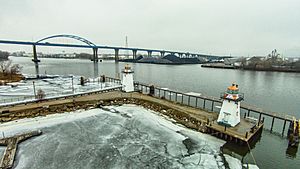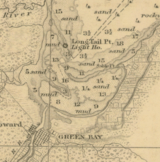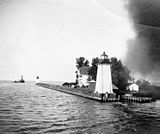Grassy Island Range Lights facts for kids
 |
|
| The Grassy Island Range Lights as relocated (2014) | |
| Location | Grassy Island north of Green Bay, Wisconsin; relocated to Green Bay Yacht Club grounds |
|---|---|
| Coordinates | 44°33′37″N 87°59′35″W / 44.56028°N 87.99306°W original; 44°32′10″N 88°00′19″W / 44.5362°N 88.0052°W current |
| Year first constructed | 1872 |
| Automated | 1934 |
| Deactivated | 1966 |
| Foundation | Pier |
| Construction | Wood with cedar shingles |
| Tower shape | Pyramidal tower |
| Focal height | |
| Original lens | sixth order Fresnel lens |
The Grassy Island Range Lights were two special lighthouses. They helped ships find their way safely into the busy harbor of Green Bay. These lights were later moved from their original spot on Grassy Island to the shore. This happened because the shipping channel needed to be made wider.
Contents
History of the Grassy Island Range Lights
Ships had trouble reaching the Fox River because of sand bars. These sand bars stuck out from both sides of Green Bay. In 1837, money was set aside to build a lighthouse there.
Early Plans for a Lighthouse
People first thought about putting a light on Grassy Island. This was the most southern of the sand bars. However, a person named Lt. Homans visited the area. He said the island was not good for building. He noted it was often underwater and a keeper could not live there. So, the Long Tail Point Light was built further north instead.
Building the Range Lights
In 1866, work began to dig a new channel into the harbor. This new channel went right through Grassy Island. Money for new lights had been approved in 1864. But there were delays with the harbor work. The money was returned, so new funds had to be approved in 1870.
The two lighthouse towers and the keeper's house were built in 1872. The towers looked very similar. They were tall, wooden towers shaped like pyramids. They were covered in wooden shingles. Each tower had an octagonal (eight-sided) lantern room at the top. Inside, they held sixth-order Fresnel lenses. These special lenses helped make the light brighter and more focused.
Initially, both lights showed a steady white light. One tower stood at each end of the new channel on its eastern side. The keeper's house was located between them.
Keeping the Lights Working
The location of the lights was very exposed to the weather. This caused some problems. The roof of the keeper's house had to be replaced in 1880. This was only about ten years after it was built. A new well was dug in 1884. The first well had filled with sand during a storm. The kitchen and boathouse were rebuilt in 1896. The boathouse was made even higher in 1902. A breakwater (a wall to protect from waves) was also built to the east of the station.
Automation and Relocation
The Grassy Island Range Lights were a good choice for automation. This means they could run without a keeper. In 1934, they were fitted with acetylene lamps. At the same time, the color of both lights was changed to green. The front light also started flashing. This helped them stand out from the city lights.
The channel was always being dredged and widened. Eventually, the decision was made to expand it even more. So, in 1966, it was decided to take the lights down. Members of the Green Bay Yacht Club asked if they could save the towers. In November of that year, the lights were moved to the club's parking lot. Much of Grassy Island was removed. A new automated light was put on what was left of the island.
In 1998, the two towers were moved again. They went to a breakwater at the edge of the yacht club property. They went through a long restoration process. They were officially rededicated in 2005. That same year, they were added to the National Register of Historic Places.
Images for kids





